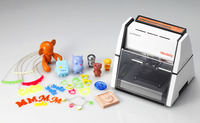 We’ve been reading a ton of posts from various online services talking about Japan-based Roland’s new “iModela 3D Printer”. This fully assembled device is able to produce 3D objects upon command and retails for under USD$1000. The iModela IM-01 comes with software to design your objects, a travel case and there’s even an online community to discuss your iModela activities.
We’ve been reading a ton of posts from various online services talking about Japan-based Roland’s new “iModela 3D Printer”. This fully assembled device is able to produce 3D objects upon command and retails for under USD$1000. The iModela IM-01 comes with software to design your objects, a travel case and there’s even an online community to discuss your iModela activities. But we noticed something.
It’s not a 3D printer.
It’s an inexpensive simplified 3D CNC Mill. It can cut a block of wax, balsa wood or plastic and carve it into arbitrary shapes (so long as the geometry permits the milling process to work). The iModela can accept a wide variety of common milling tools from model shops.
Why isn’t it a 3D printer? Well, for one thing it uses “Subtractive Manufacturing”, the taking-away of material to reveal the final object, while 3D printing, as it has come to be known, uses “Additive Manufacturing”, where material is gradually added to form the final object.
While we’re certain this is a fine hobby mill, we’re wondering about the public’s understanding of 3D Printing technology. How did so many blogs immediately mistake this mill for a 3D printer? At no point on Roland’s web page does it claim to be a 3D printer. Instead, Roland explicitly states in its headline no less, that it’s an “Affordable 3D Hobby Mill”.
Nevertheless, it does produce 3D objects, as do many other technologies. But we’re here to talk about 3D printing.
Via Roland

